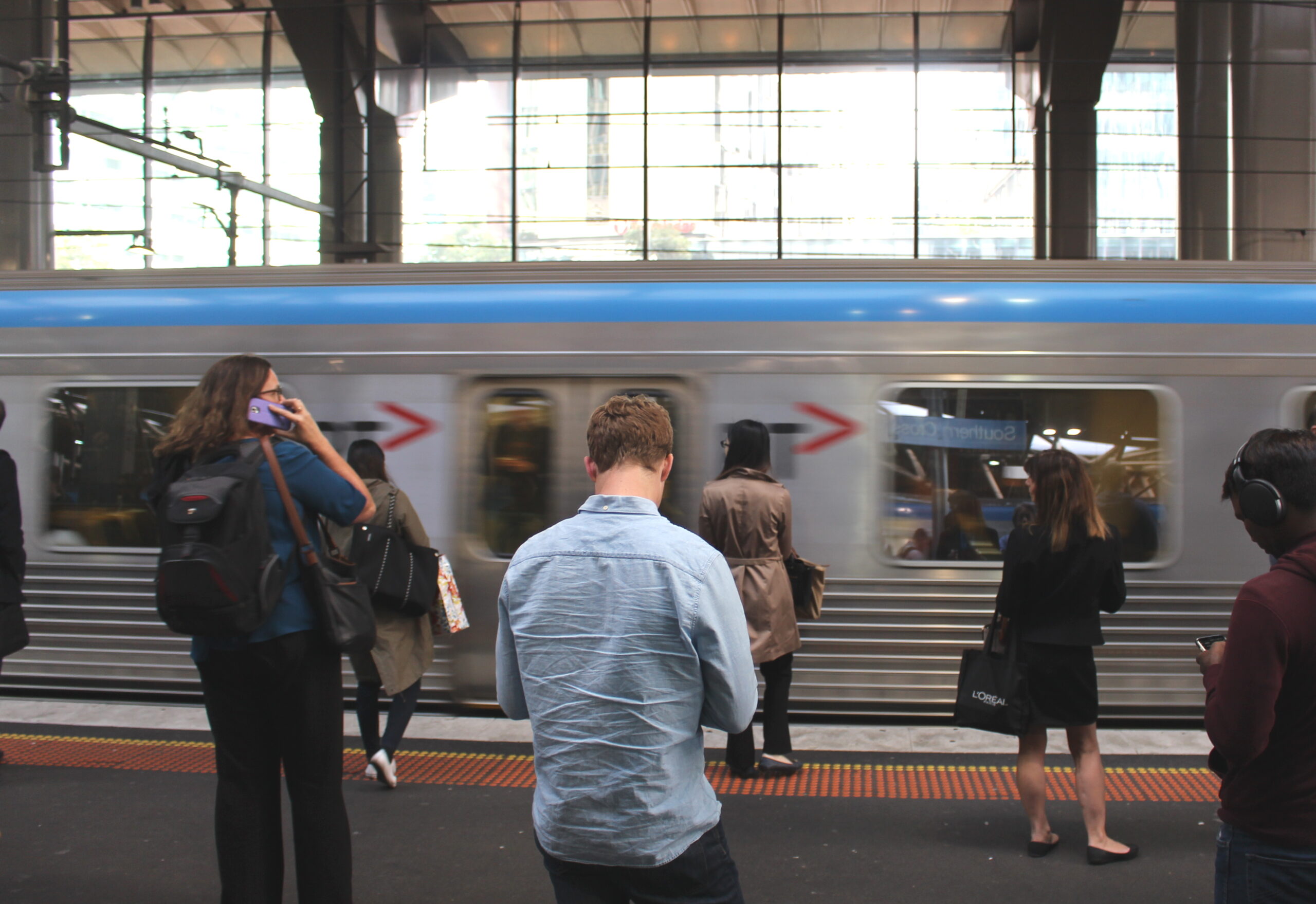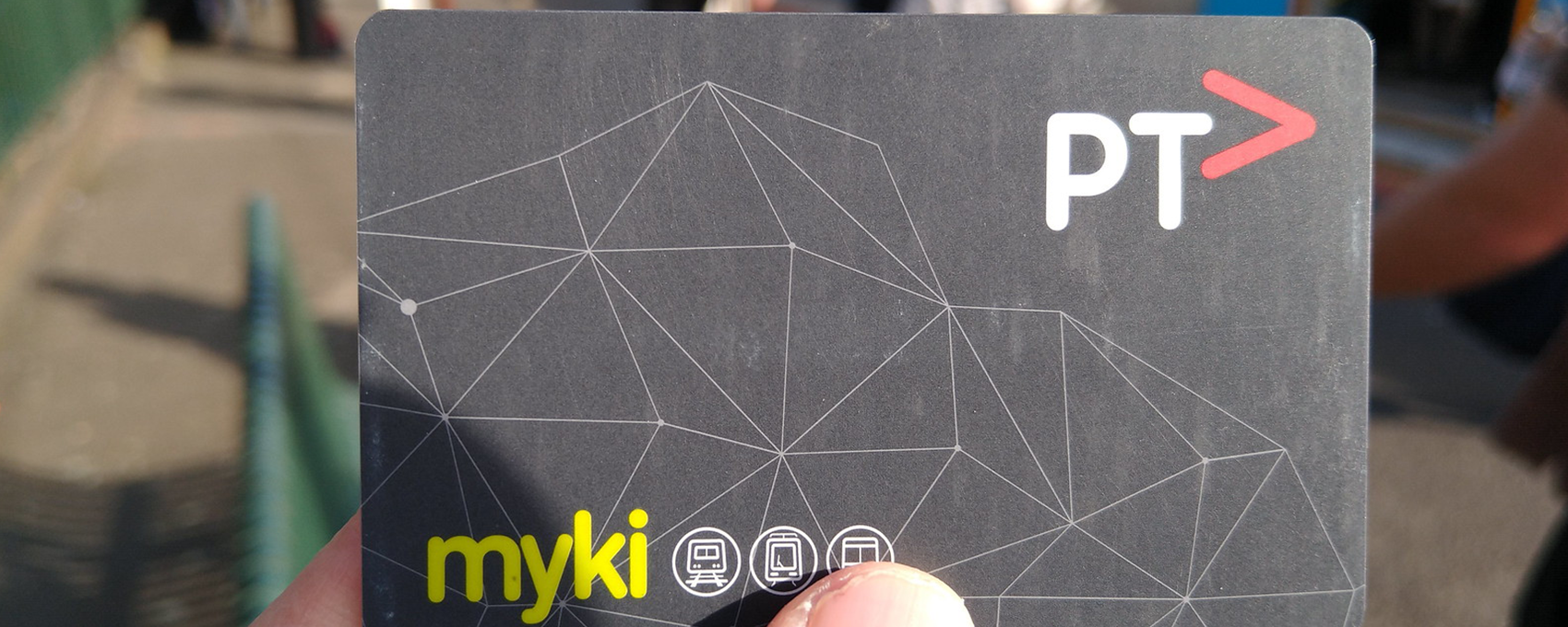Updated October 2025
Most public transport users in Victoria have to use the trouble-plagued Myki ticketing system, people need simple answers to basic questions about it. This page is an effort to explain how the Myki system works, and answer the main questions we are asked.
Where can I get a Myki?
You can buy a myki card from:
- Myki Card Vending Machines located at stations, some tram stops and some bus interchanges.
- Staff at Premium (staffed) stations
- Staff at V/Line stations between Melbourne and Geelong, Ballarat, Bendigo, Traralgon and Seymour
- The PTV Hub at Southern Cross station.
- Retail outles accross Victoria including all 7-Eleven stores.
- The Transport Victoria Website, Cards can take up to two weeks to arrive when purchasing online.
- The 1800 800 007 phone number, Open 6am – midnight daily. Cards can take up to two weeks to arrive when purchasing over the phone.
Those who have NFC-equipped Android Phones can also purchase a Mobile Myki from the Google Wallet App.
Those who live in Regional Victoria outside of the Myki boundary can purchase pre-loaded myki cards from some staffed V/Line stations,
You can check if your nearest stations offers this and check opening hours on the V/Line website.
How much does getting a Myki card cost?
The cost of a card is $6 full fare, or $3 concession. The purchase price is not refundable. The card cost alone can not be used for travel, an additional top up is required.
Those who are eligible for a free Seniors Myki should apply for one as part of their application for a Seniors Card.
Myki Card Vending Machines only dispense full-fare cards.
Concession, Child and Seniors cards can be purchased from staffed railway stations, retail outlets, at the PTV Hub, or online.
Where can I add money to my Myki?
You can top up your Myki from:
- The PTV App on a NFC-equipped smartphone.
- Myki Card Vending Machines locatied at stations, some tram stops and some bus interchanges.
- Staff at at Premium (staffed) stations
- Staff at V/Line stations between Melbourne and Geelong, Ballarat, Bendigo, Traralgon and Seymour
- The PTV Hub at Southern Cross station.
- Retail outlets across Victoria including all 7-Eleven stores.
- The Transport Victoria Website, Cards can take up to two weeks to arrive when purchasing online.
- The 1800 800 007 phone number, Open 6am – midnight daily. Cards can take up to two weeks to arrive when purchasing over the phone.
Why can’t I get a short-term ticket?
 A short-term ticket (pictured) was originally planned for people without a Myki, but for reasons never clearly explained the state government decided not to introduce them in Victoria.
A short-term ticket (pictured) was originally planned for people without a Myki, but for reasons never clearly explained the state government decided not to introduce them in Victoria.
With no short-term option, anyone wanting to use public transport in Melbourne must buy a reusable Myki card and load it with credit, even if they only travel occasionally. This is particularly inconvenient for interstate or international travellers. Even regular users can face problems. If they forget their Myki, they must buy another one and top it up.
The benefits of short-term tickets were clear. Before their abolition on major regional city bus networks in April 2013, up to sixty percent of passengers were using them.
How does Myki Money work?
You buy a re-usable Myki card and load credit onto it. As you travel you touch on and touch off, and the system will debit your Myki card as you go. Melbourne metropolitan fares are shown in the following table. Regional fares differ from this. For full details of fares see the relevant page of the Transport Victoria website.
| Zones | 1 | 2 | 1 and 2 |
|---|---|---|---|
| 2-hour | $5.50 | $3.50 | $5.50 |
| Daily | $11.00 | $7.00 | $11.00 |
Concession fares are 50% of the above prices. Discounts (e.g. Earlybird free travel on trains before 7 a.m.* and Weekend Cap $6.30) apply to Myki Money.
Note that the 2-hour period is exactly that and is timed from the moment you touch on. However, if you touch on after 6 p.m., the 2-hour fare applies until 3 a.m. the next day.
A “daily cap” applies: if you make multiple trips in one day, the system charges you a maximum of two 2-hour segments, e.g. the Daily fare.
If your travel is eligible for the Weekend Saver daily fare (Saturdays, Sundays and public holidays), then Myki charges you a maximum of $6.30 per day ($3.15 concession). If you’re a Senior, the normal daily cap is $4.30, but on weekends, Seniors receive free travel for trips entirely within one or two consecutive zones (including within Zones 1 and 2), and on regional town bus services. Note that even though they are not charged under those circumstances, Seniors are still required to touch on and off.
*Under Earlybird there is actually a 15-minute grace period to allow for late trains, so Myki gives you free travel on trains if you touch on and touch off by 7:15 a.m.
How does Myki Pass work?
Myki Pass is what used to be called a periodical ticket.
You buy the normal Myki card and then choose to add credit to turn it into a periodical “pass” for your chosen period — for 7 days, or anything from 28 to 365 days — for the zone or zones you want. Note that these are consecutive days, and are not related to calendar months.
So the price for a “monthly” Pass is based on a particular number of days, not on a calendar month (where the number of days varies).
Current Myki Pass fare prices are listed on the Transport Victoria website.
Public Transport Users Association Members can access discounted 365-day Myki Pass which provides a more than 9% reduction on the retail price
Commuter Club Mykis are specially-coded Myki cards which are provided free with the discounted Yearly fare.
Can I combine Myki Pass and Myki Money?
Yes. A single Myki card can have a Myki Pass for travel in your usual zone or zones, and also have Myki Money loaded on it for occasional trips into other zones, including V/Line services.
What is Mobile Myki?
Mobile Myki is a way of paying Myki fares using a mobile phone.
It is available on phones with recent versions of Android (5.0 and higher) that have NFC (Near-Field Communication). NFC is used by the phone to communicate with Myki readers so you can touch-on and off as you travel.
Mobile Myki works within the Google Wallet App. You can use it to create an adult or concession virtual Myki card on your phone. Unlike a physical card, it is free, but it does need to be linked to a Google account. Once set up, it can be loaded with Myki Money or some types of Myki Pass.
You can then use your phone to touch on and off. Depending on your phone it may or may not need to be unlocked.
There are more details on how to set it up on the Transport Victoria website.
Is Mobile Myki available on iPhones?
Not yet. It is in development and is expected to be introduced alongside contactless credit card payments. New readers are currently being rolled out in preparation for these changes.
For more information on the myki contactless upgrade, visit the Transport Victoria website.
What about paying with contactless credit cards?
That option is available in some cities, such as Sydney and London, and is particularly useful for tourists. In Victoria, it is in development, with new readers currently being rolled out in preparation for contactless payments.
For more information on the myki contactless upgrade, visit the Transport Victoria website.
How does Myki work on V/Line commuter train services?
Myki operates on V/Line’s commuter services between Melbourne and:
- Waurn Ponds on the Geelong Line
- Wendouree on Ballarat Line
- Raywood or Goornong the Bendigo Line
- Seymour on the Seymour Line
- Traralgon on the Gipsland Line
Every V/Line commuter station is located in a fare zone from 3 to 16.
You can view the fares for Regional Train Myki travel on the Transport Victoria website.
Passengers taking long journeys on V/Line commuter services are given additional time to complete their journey without incurring any extra fare. Note: Some increases in this allowance were made on 1 January 2016
- Travel across 3-5 Zones : 2½ hours allowed
- Travel across 6-8 Zones: 3 hours allowed
- Travel across 9-11 Zones: 3½ hours allowed
- Travel across 12-13 Zones: 4 hours allowed
How does Myki work on V/Line long distance train services?
Myki cannot be used for travel on long distance services traveling to/from any station between:
- Waurn Ponds and Warrnambool
- Wendouree and Ararat
- Ballarat and Maryborough
- Raywood and Swan Hill
- Goornong and Echuca
- Seymour and Shepparton
- Seymour and Albury
- Traralgon and Bairnsdale
If you are using any other form of public transport on the same day you travel to/from any V/Line long distance station ensure you pre-purchase your V/Line ticket to avoid paying more than the daily cap. Per section 5.15 of the Victorian Fares and Ticketing Conditions your V/Line ticket entitles you to 2 hours of free travel on either side of a V/Line journey as indicated by the printed codes beside destinations on your ticket.
- Z1+2 entitles you to travel in Zones 1 and 2.
- Z2 entitles you to travel in Zone 2
- BTS entitles you to travel on Ballarat or Bendigo bus services depending on your printed destination.
- GTS entitles you to travel on Geelong bus services
- T/Bus entitles you to travel on local bus services within your printed destination.
If you are traveling on a Melbourne train tram or bus service to connect with a long distance V/Line service it is highly likely you will not need a Myki. You will just need to check the Z1+2 code is printed on your ticket and then display this to fare gate staff, bus drivers or Authorised Officers.
How does Myki work on V/Line coaches or buses outside of the commuter zone?
It doesn’t! You are required to use another type of ticket. The government has promised an expansion of the Myki system multiple times. The latest commitment is that it will coincide with the introduction of contactless credit card payments, but no rollout timeline has been announced.
To travel on V/Line coaches you will need a V/Line ticket
For more information on V/Line tickets see the V/Line website.
To travel on local bus services in
- Bairnsdale
- Benalla
- Cobram
- Colac
- Drouin
- Echuca/Moama
- Gisborne
- Hamilton
- Horsham
- Korumburra
- Kyneton
- Lakes Entrance
- Maryborough
- Mildura
- Portland
- Rochester
- Sale
- Shepparton/Mooroopna
- Swan Hill
- Wangaratta
- Warrnambool
- Wodonga
- Wonthaggi
- Yarrawonga
you will need a Category A regional bus ticket, these can be purchased from the driver.
For more information on regional bus tickets see the Regional Bus fares supplement.
To travel on local bus services in
- Ararat
- Beaufort
- Stawell
you will need a Category B regional bus ticket, these can be purchased from the driver.
For more information on regional bus tickets see the Regional Bus fares supplement.
Does the PTUA provide discounted Yearly tickets under the Commuter Club scheme?
Yes. PTUA members who are regular public transport users can buy discounted Yearly tickets, at about 9% off the retail price, and that includes a free Myki card. You can see full details of the offer here. Commuter Club is also available via some employers.
Commuter Club is only a Melbourne metropolitan program. Even though Myki is used on V/Line commuter services, there is no plan to extend Commuter Club availability beyond the metropolitan area.
However, passengers travelling to Melbourne from Zone 2 stations which are only served by V/Line trains, such as Tarneit, Wyndham Vale or Melton, are eligible for Commuter Club.
Can I get a refund if I no longer need the Myki Pass I purchased?
You can apply for a refund of a partly-used Myki Pass or an unused Myki Pass, as well as unused Myki Money. You can do that by filling out an online application. However refunds are not available on expired Passes, and you cannot get a refund of the purchase price of a Myki card ($6 or $3 concession) .
Can Myki be used to track my movements?
You can choose to register your Myki, or not, as you wish.
It is possible to get a card completely anonymously from Myki vending machines or over the counter. Unregistered cards get access to the same fares.
If you register your card you are protected against theft or the loss of the card, because you can report the loss, have your Myki deactivated, and have the remaining credit balance transferred to a new card. You can also set a registered card to be topped up automatically with money from your bank account.
The government has published a privacy policy which goes into some detail about when they might provide someone’s travel data to authorities. You can read it here.
Can someone else use my Myki?
It is perfectly legal for other people to use your Myki, provided that it only has Myki Money loaded on it. However you are not allowed to share your card if Myki Pass is loaded on it.
Does the credit on my card expire if I haven’t used it for 90 days?
No it does not. This idea was once widespread but completely false.
I’ve heard that a Myki card has an expiry date.
This is correct Myki card expires four years after the card is first topped up and fustratingly the expiry date is not shown on the card itself.
You can find out when your card expires by checking it on a Myki Card Vending Machine, by ringing 1800 800 007 and quoting the card number. or by registering your myki online.
When your Myki expires you can go to any staffed railway station or PTV Hub to get a free replacement card. The remaining balance on your old card will be transferred to the new one. If your Myki has a negative balance, you will have to top-up to a positive balance as part of the replacement process.
If your expired Myki is registered, the replacement card will also be automatically registered. However, if you have auto top up linked to your expired Myki, you will have arrange auto top up again for your new card.
Can I travel if my Myki has a negative or debit balance?
Only in certain circumstances. Your Myki must have a balance of at least $0.00 (i.e. not negative) for you to be able to touch on, but you can go into negative balance during the journey. If you break the journey, your Myki goes into negative balance, and any other touch on will be refused, even if the two-hour or daily travel period has not expired.
It is also important to note that even though the Myki Pass on your card may be valid for travel, you cannot commence a journey using Myki Pass if the Myki Money balance on that card is negative. For your Myki Pass to be valid, your Myki Money balance must be at least $0.00.
How do I touch on and touch off?
Touching on and touching off allows the system to know what to charge you, although touching off on trams is optional (see below).
Touch on your Myki at a reader when you enter a station, or when you board a tram or bus. Touch off at a reader when you leave the station, or when you get off the tram or bus.
One of the major problems with the system in its original form was that the response times of the readers were far too slow. This caused long queues at station exits and increased dwell times for buses and trams. After more than 15 years, all the old readers are finally being replaced, with new devices rolling out from 2025. These readers are being introduced in preperation for contactless credit card payments and are consistently faster than both types of readers that came before them.
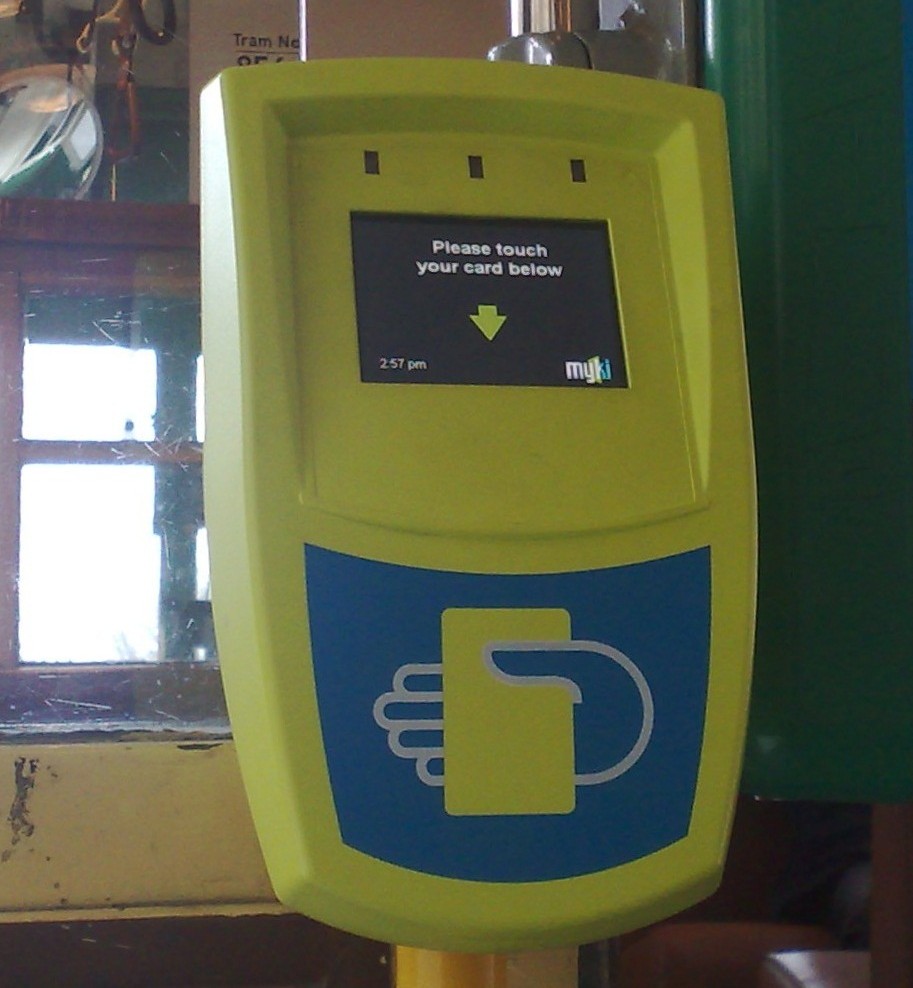
First Generation Myki Reader
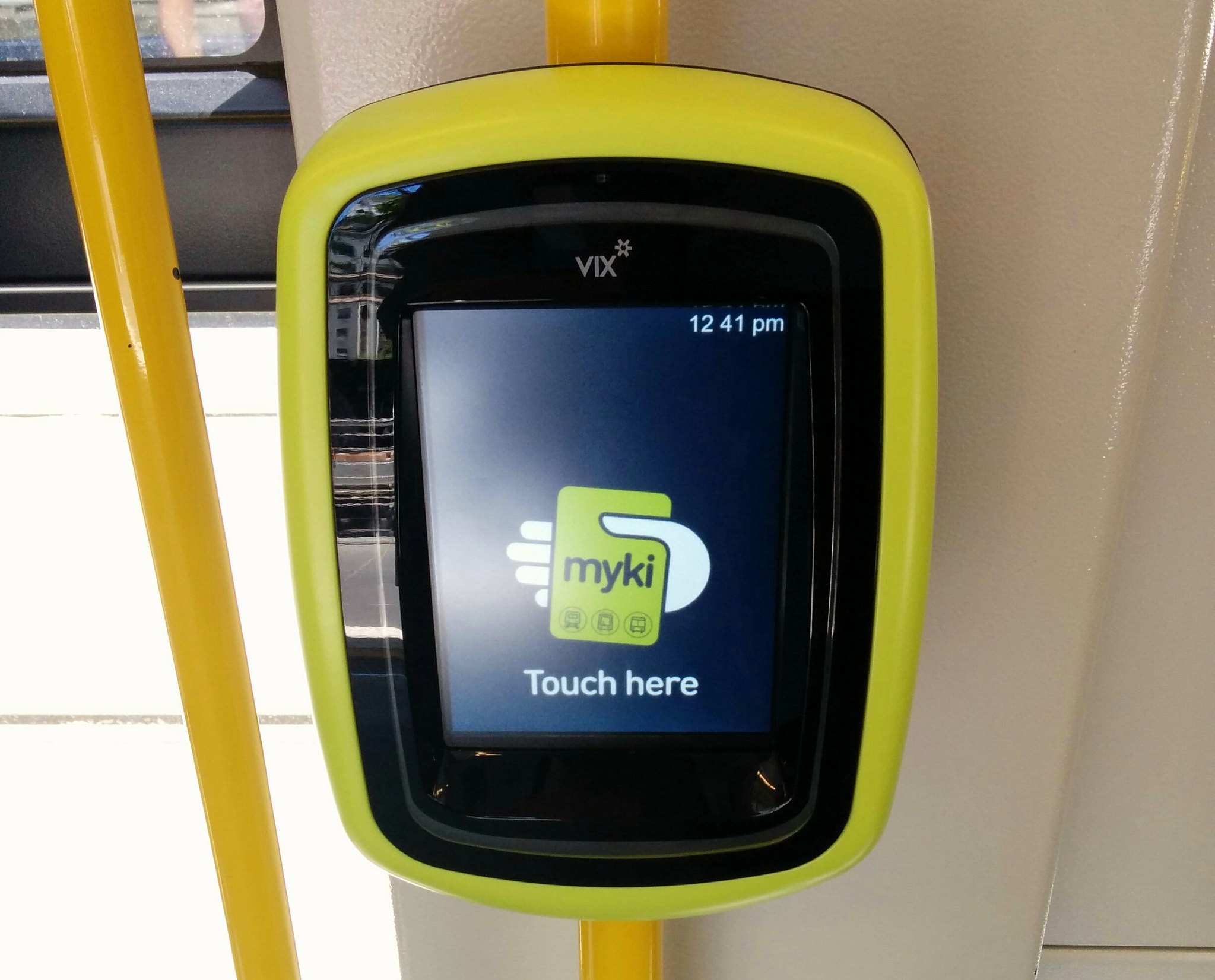
Second Generation (Vix) Myki Reader
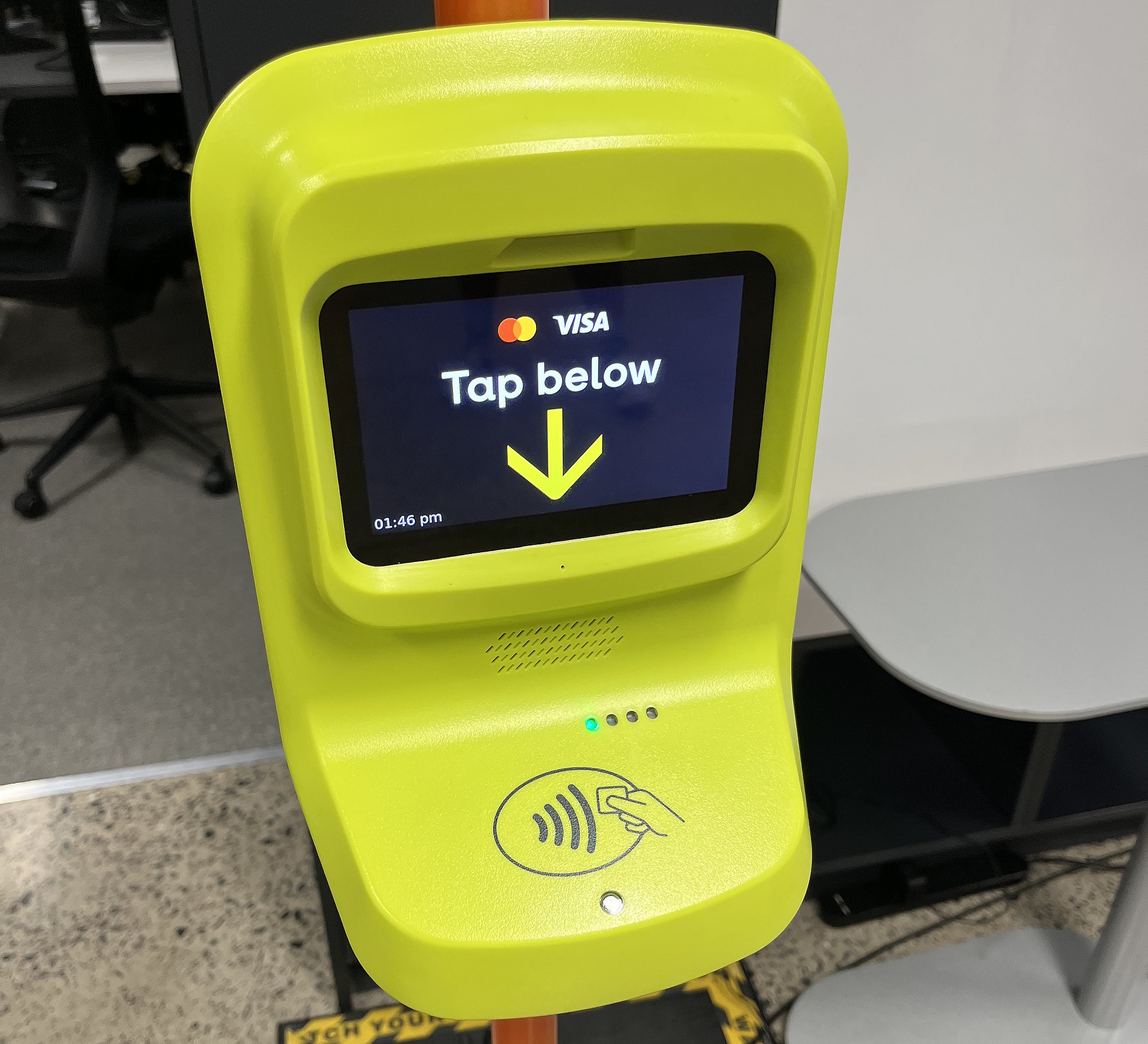
Third Generation (Conduent) Myki Reader
Do I really need to touch on every time?
You need to touch on every time you enter a station, tram or bus to ensure your ticket is valid for travel, even if you have already touched on somewhere else for the particular journey you are undertaking.
In reality, you must touch on the first time you use a ticket for a particular journey, to set its expiry date and time. Not doing so is fare evasion.
There is an exception to that, however. You don’t have to touch on or off if you travel on a tram entirely within the Free Tram Zone which covers Melbourne’s CBD and Docklands. There is a map of the Free Tram Zone here.
But if your journey starts or finishes outside the boundaries of the Free Tram Zone, you must touch on your Myki in the normal way to make sure you have a valid ticket.
You must touch on when boarding a bus, even if your ticket is already valid for that journey, so that the bus driver knows you have a valid ticket. You must also touch on when boarding at railway stations if your destination is a gated station, otherwise the gates at your destination may not let you out, and you may have to queue for staff assistance.
You should also touch on and touch off if you are travelling on a Myki Pass outside the zone(s) you have paid for.
Do I really need to touch off every time?
The official statment is you should always touch on and off except on trams, for most trips this will ensure you pay the correct fare but there are some circumstances where this is not stictly nessarary and some circumstances where you should tocuh off on trams (see next section)
If you do not touch off the systtem will charge a default fare, which can be higher than the correct fare. The default fare is applied when the system does not know where you finished your trip so it assumes you travelled to the end of the line on a tram or bus, or to the last station on the longest train line. You should always touch off when using Myki Money to avoid being overcharged.
However Myki Pass users, don’t nessararly need to touch off when travelling wholly within their nominated zone, as the fare is already covered. As you have pre-paid for what you want you can’t be overcharged by not touching off.
The government encourages touching on and off for data collection, but similar information was gathered under the old Metcard system and through surveys. This has not stopped crowding caused by poor planning in recent years.
Why don’t I have to touch off on trams?
To avoid congestion from large numbers of people touching off at busy stops, all tram routes were set to fall within Zone 1. This means the default fare on trams is always a Zone 1 fare, and both the operator and the government encourage passengers not to touch off to help reduce dwell times.
However, if you travel entirely within the Zone 1/2 overlap at the outer ends of routes 75, 86 and 109, you should touch off to ensure you are charged the cheaper Zone 2 fare.
Do I get charged for another 2-hours if I touch off after the expiry time?
No. Your Myki ticket is valid as long as you touch on at a station, or board the tram or bus, before the expiry time.
I heard weekly/monthly/yearly Passes aren’t valid on weekends.
That is not true. They are valid on weekends, but only in the zones you’ve paid for.
A single-zone weekly/monthly/yearly Metcard used to be valid in both Melbourne zones on Saturdays and Sundays. That benefit has been withdrawn under Myki. The government argues that is necessary in order to be consistent with regional areas, and yet no regional area has the $6.30 weekend daily fare cap which is available in Melbourne.
The result is that Myki Pass users must pay extra if they travel into another zone. But their total fare will attract the $6.30 weekend/public holiday cap, and what has already been paid towards that is taken into account.
Why does the information displayed on the reader vanish too quickly for me to read it?
The information showing your card balance, and the amount deducted for your journey, will be displayed for as long as you hold your card to the reader, so hold it up for longer if you want to check that information. However, some of the new card readers on railway station barriers do not display any information about the status of the card.
You can also use a Myki Card Vending Machine to find out the status of your card.
Does Myki Money always give me the best fare?
It does give you the best daily fare, by charging you the cheapest possible fare for each trip, and upgrading it automatically, for instance from a 2-hour Zone 1, to a Daily Zone 1+2, whatever is cheapest for your day’s travel.
But if you use it every day, the system does not automatically upgrade you to a cheaper 7-day Pass or a 30-day Pass etc. Myki Pass must be pre-loaded to attract the cheaper periodical fare.
I heard you have to pay extra if the train is late.
No, not on trains, but you may be affected if you want to make use of the 2-hour fare and you catch trams and buses.
Under Myki, your ticket is valid as long as you start your trip (that is, touch on at the station, or as you board the tram or bus) before the 2-hour travel time expires.
This is only a problem when using trams and buses, because you only touch on as you board. When using trains you can enter the platform and touch on before the expiry time, no matter how late the train you are catching might be.
If you are going to travel for more than 2 hours it makes no difference to you, but if you are trying to make a couple of short trips using a bus or tram in a single 2-hour period, with no other travel that day, you will be charged the daily fare if the bus or tram arrives late, after your 2-hours has expired.
What’s the use of compensation being paid as Myki Money, when I have a Myki Pass?
Monetary compensation for poor service delivery can only be claimed if you have travelled for 10 or more days with a Myki Pass that is for 28 days or longer.
When Yarra Trams, Metro Trains or V/Line miss their monthly performance targets, you can claim compensation. Given the electronic nature of the Myki system, it is ridiculous that getting compensation is a manual process, involving filling in a form and posting it. It seems obvious that the system is designed to discourage passengers from getting the compensation they are owed.
Compensation is paid as the Myki Money equivalent of the zones covered by the Pass, rather than extending the duration of the Pass.
There are several ways to make use of the Myki Money compensation:
- Use it after your Pass expires. Note, however, that if you have another Pass loaded on your card, the Myki system will always use that first if it is valid for your trip.
- Use it for travel in other zones, including V/Line journeys.
- Request that the compensation amount is added to a different Myki card, such as a family member’s card, or a second card that you use. This option is on the form.
- Pay for your next Myki Pass using Myki Money. This is done by putting enough Myki Money on your card to pay for the Pass, then choosing the option on vending machine to buy a Pass with Myki Money. Unfortunately this option appears to only be available from vending machines.
Is Myki switching us to distance based fares?
No. The current zone system is being retained.
Hong Kong and Singapore and some other cities use fares based on how many kilometres you travel. Myki does not include this change and fares remain almost identical to those under Metcard, based on the zones (which will now spread across Victoria) and duration (2-hour, daily, etc.) of travel.
The PTUA believes that distance based charging has some disadvantages − it may lead to higher fares, and it is quite confusing, because you might not know how much you’ll be charged before you travel.
How do ticket inspectors and V/Line conductors check tickets?
There is little information printed on the Myki card itself, and no obvious way of telling whether you have validated correctly or not. Authorised Officers (ticket inspectors) and V/Line conductors use hand-held devices that can read the cards.
Has Myki slowed things down?
Yes, in some situations.
Station exits have often become congested as train loads of people queue to touch off. The unacceptably slow and inconsistent response times of the original card readers made this worse. After more than 15 years, all the old readers are finally being replaced, with new devices rolling out from 2025. These readers are being introduced in preparation for contactless credit card payments and are consistently faster than both types of readers that came before them. Hopefully this will reduce congestion.
Buses have benefited from faster boarding times, especially after cash top-ups were stopped during and after the COVID-19 pandemic. However, this also means bus passengers now face the same issue as tram passengers, as they can no longer buy a valid ticket on board.
The operator and the government encourage passengers not to touch off to help reduce dwell times (see above). Whether delays occur depends to a great extent on how quickly the readers respond, and how many there are.
Does Myki work properly?
Virtually every aspect of Myki’s original introduction was poorly handled. The PTUA flagged a number of design and implementation problems with Myki that need fixing, and we are continuing to give feedback to the government as the rollout of new readers and contactless payments progresses.
The biggest drawback with the Myki system is the state government’s unexplained decision not to make single-use tickets available, meaning that every public transport user must have a Myki card, loaded with sufficient credit, to be able to travel. This makes things extremely difficult for tourists, for new and occasional public transport users, or for passengers who have problems with their Myki, and it will be a further source of fare evasion.
As noted above, the other major and persistent problem with the operation of Myki is that response times of card readers are inconsistent and often too slow − sometimes they respond in under a second, but very often they take a good deal longer. That is unacceptable, and it has been allowed to continue for far too long.
As soon as Myki began operating, the PTUA asked that different sounds be introduced for a touch on and a touch off. Instead of that, we got the totally unnecessary introduction of a double beep for concession passengers.
Opportunities for buying and topping up cards are still too limited, especially for tram and bus users.
Watch the system very carefully to ensure you’re being charged correctly. Keep a close eye on the Myki readers as you use them, check your transactions on the Myki Check machines (the blue machines in stations and some trams stops) at vending machines and/or via the PTV web site, and ring 1800 800 007 or contact PTV online if you suspect you have been overcharged.
Was it worth the money?
Probably not. Although the Myki system brings some benefits, including better access to cheap fares, these are eclipsed by the enormous cost of the system.
Few passengers wanted a new ticket system, and the PTUA argued that for a fraction of the cost, either the previous Metcard system could have been updated, or a cheaper Smartcard system bought from elsewhere. The money saved could have been spent on more staff, trains, trams and buses. But the change has happened, so we’re providing feedback to the government to try and improve the outcome for passengers.
Further questions?
If you want to read all the fine print yourself, it’s contained in the Victorian Fares and Ticketing Manual. Be warned, the Manual is over 100 pages long.
For assistance using myki or any other ticketing enquireies you can
- Speak with staff at Premium (staffed) stations
- Speak with staff at V/Line stations between Melbourne and Geelong, Ballarat, Bendigo, Traralgon and Seymour
- Visit the PTV Hub at Southern Cross station.
- Visit the Transport Victoria Website.
- Call 1800 800 007, Open 6am – midnight daily.
If you encounter any issues with the Myki system, please email office@ptua.org.au and we will endeavour to assist where we can.
What is the PTUA anyway?
Founded in 1976, the Public Transport Users Association is the recognised consumer organisation advocating for better public transport across the state.
We are a non-profit, voluntary organisation with no political affiliations. If you would like to support our work, please consider joining us. The benefits of membership are outlined below.
Standard Member | Gold Member | Concession Member | Monthly Member | Supporter | |
|---|---|---|---|---|---|
| $50 yearly | $200 yearly | $25 yearly | $4.50 monthly | Free | |
Support the work of the PTUA | |||||
Monthly email update | |||||
Member Newsletters | |||||
Access to Member Events | |||||
PTUA Voting Rights | |||||
Discounted Annual Myki |
